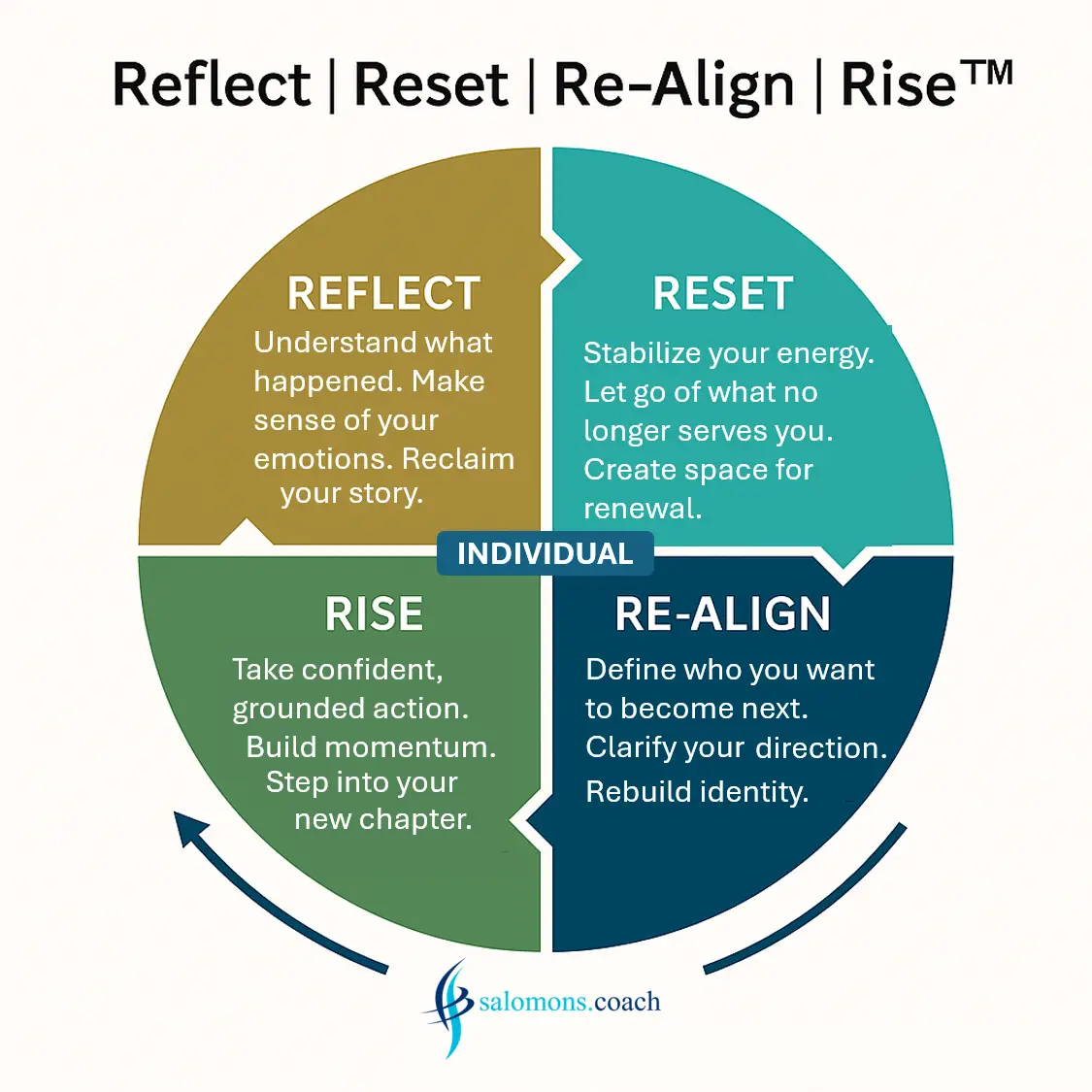4R model – Reflect, Reset, Re-Align, Rise™

The 4R Model: A Practical Roadmap Through Disruption and Transition
(and why it’s grounded in both experience and science)
When people go through redundancy, burnout, or a major career shift, what I see most often is not a lack of talent, but a lack of structure for the inner journey.
On paper, the transition looks “simple”: job ends → new role begins. People say “life goes on…”.
In real life, it’s messy: identity questions, emotional turbulence, doubts about value, family pressure, market uncertainty.
The 4R model – Reflect, Reset, Re-Align, Rise™ – grew out of 35+ years of working as a leader and coach in complex organizations across logistics, IT, and the semiconductor industry. It is my way of giving that inner journey a clear, humane and evidence-informed path.
Below, I’ll explain the fundamentals of the model, the experiences that shaped it, and how it connects to globally fundamental research.
Where the 4R model comes from
Across my career – from leading large operational teams at TNT/FedEx to working with manufacturing and tech organizations – I saw the same pattern:
- Restructurings and reorganizations handled as HR and legal events, not human transitions.
- Leaders and employees expected to “move on” quickly, while their emotional and identity process lagged behind.
- People making rushed career choices, only to realise months later they hadn’t really reset anything.
As an executive and later as a coach, I sat on both sides of the table:
- The side that had to announce redundancies and redesign organizations (and have the bad-news conversations)
- And the side that helped individuals rebuild confidence, identity and direction afterwards.
Over time, I noticed that people who came out stronger from these experiences unconsciously moved through a set of recurring phases – while those who got stuck had skipped or rushed them.
Another component that helped me better understand the psychological process, were my change and transformation projects, where the human transition is the one and only key success factor.
That recurring pattern became the 4R model.
The 4R Model in short

1. Reflect – “What is really happening to me?”
This phase is about making sense of the shock:
- Naming emotions, stories, fears, and assumptions.
- Seeing how previous experiences, beliefs, and identity play into today’s reaction.
- Building self-awareness about patterns: over-responsibility, perfectionism, conflict avoidance, etc.
Research consistently shows that self-awareness is the starting point for effective leadership and healthy adaptation. Harvard Business Review and others note it as the first component of emotional intelligence and a core predictor of leadership effectiveness and performance. Harvard Business Review+1
In practice, Reflect is where we (must) slow down enough to see clearly: What am I actually thinking, feeling, and telling myself?
2. Reset – “What needs to stop, end, or be released?”
This is the phase many people – and organizations – are tempted to skip.
Here we work on:
- Letting go of the old role, identity, or story (“If I’m not that job title, who am I?”).
- Challenging unhelpful beliefs (“I failed,” “I’m too old,” “I must climb higher or I’m going backwards”).
- Giving space to grief, anger, shock, or shame – without letting it define the future.
The Reset stage strongly resonates with William Bridges’ Transition Model, which distinguishes between change (external) and transition (internal). Bridges describes transition as moving through three phases: Ending/Losing/Letting Go, the Neutral Zone, and the New Beginning – each at its own pace. William Bridges Associates+1
4R builds on this by giving more language and practical tools to that inner “ending” and “neutral zone” for people navigating redundancy or career change.
3. Re-Align – “Who do I want to be and how will I show up?”
Once the emotional dust settles and the old role is no longer the main reference point, we can start to:
- Reconnect with values, strengths, and deeper motivations.
- Rebuild a leadership or career identity that fits the next chapter.
- Experiment with new narratives: how you introduce yourself, what roles you target, how you want to contribute.
Recent research on coaching and leadership emphasizes identity work as a key “active ingredient” in effective coaching: when leaders consciously work on who they are becoming, transitions are more successful and outcomes more sustainable. Philosophy of coaching
In 4R, Re-Align is where we do that identity work deliberately rather than leaving it to chance.
4. Rise – “How do I turn insight into sustainable action?”
Rise is not about a heroic comeback; it’s about grounded momentum:
- Turning clarity into concrete career steps or leadership behaviours.
- Testing new habits in real contexts: boundary-setting, communication, decision-making.
- Building resilience, routines, and support systems that make success sustainable.
At this stage, we lean heavily on experimentation in psychologically safe environments. Amy Edmondson’s research at Harvard shows that teams and individuals learn and innovate better when they feel safe to speak up, try, and make mistakes without fear of punishment. MIT on Psychological Safety
In coaching, that psychological safety allows clients to try out new scripts, behaviours, and choices before they take them into high-stakes environments.
How my experience shaped each phase
The 4R model is not something I invented in a workshop room; it is something I observed in real people over decades and then structured.
- As a managing director in a competitive logistics environment, I saw how short-term restructurings created long-term emotional and cultural scars when people weren’t supported in their transition.
- As a leader in large operations and later in high-tech manufacturing, I saw how constant VUCA conditions – volatility, uncertainty, complexity, ambiguity – amplified the pressure on people’s identities, not just their workloads.
- As an executive coach working with senior leaders and professionals facing redundancy, burnout, or career crossroads, I saw that those who did well had, often unconsciously, moved through a sequence of reflecting, letting go, re-aligning, and rising.
- Or on the contrary, the executive struggling with decisions on making people redundant and support the designing the outplacement process that respected the psychological needs of the people affected (and ensure internal communication maintained respect and motivation on the people not affected).
My work with clients going through redundancy echoes what HBR and other sources have highlighted: layoffs and job loss are rarely purely performance issues; they are often driven by systemic business factors and carry significant psychological and identity impact for those affected. HBR on emotions whilst being laid-off
The 4R model is my way of giving that process a clear container – so people don’t just “survive” it but grow through it.
The theoretical backbone behind 4R
To summarise, the 4R model is grounded in four main strands of evidence:
1. Transition Theory (Bridges and others)
- Bridges’ Transition Model shows that people move from Endings to a Neutral Zone and then to New Beginnings, and that the psychological journey is different from the organizational change plan. Bridges Transition Model
- 4R refines and operationalizes these phases for modern careers and leadership transitions, especially under VUCA conditions.
2. Emotional Intelligence & Self-Awareness
- Emotional intelligence – especially self-awareness, self-regulation, and empathy – is now widely recognized as a core leadership capability and a strong predictor of performance. HBR: How Emotional Intelligence Became a Key Leadership Skill
- Reflect and Reset deliberately cultivate these capabilities so that later decisions (Re-Align, Rise) are grounded rather than reactive.
3. Identity Work in Coaching
- Emerging research on coaching shows that leader identity work is central to transformative outcomes: when clients actively explore and reshape who they are as leaders and professionals, coaching has deeper and more durable impact. Philosophy of coaching
- Re-Align focuses precisely on this: aligning behaviour, choices, and career direction with a renewed sense of self.
4. Psychological Safety & Learning
- Edmondson’s work on psychological safety shows that people and teams learn, innovate, and adapt better when they feel safe to take interpersonal risks. HBR: Psychological Safety and Learning Behavior in Work Teams
- Rise makes use of that: the coaching relationship becomes a safe “lab” where new behaviours can be practised, reflected on, and strengthened before they are exposed to organisational realities.
Why this matters now
We are in a period where:
- Layoffs and restructurings are more frequent.
- Mid-career professionals (45+) are at higher risk of long-term unemployment and face complex identity and market challenges. HBR: Shifting Your Perception After Being Laid Off
- Many people are questioning not just what they do, but how and why they want to work.
Organizations often handle the administrative side of these transitions well, but the human side remains under-served.
The 4R model offers a structured, evidence-informed way to support that human journey – for individuals and for organizations that want to treat people with dignity, even in difficult moments.
How I use the 4R model in practice
In my coaching practice at Salomons.Coach, I use the 4R model to guide:
- Professionals who have been made redundant and want to rebuild with intention rather than urgency.
- Leaders who feel they have “outgrown” their role but don’t yet know what the next chapter should look like.
- Senior managers who are at risk of burnout and need to redesign how they lead and live.
- Organizations that want their outplacement and transition processes to be more humane, effective, and reputationally sound.
The model is not a rigid sequence; it’s a compass. People move back and forth between phases – and that’s normal. What matters is that each R gets its place, so that when someone rises, they rise on a solid foundation.
If you’d like to explore how the 4R model could support you personally, your team, or your organization’s outplacement approach, we can start with a reflective conversation — often, that first “R” already brings more clarity than you expect.
Contact me here: Contact-Page



